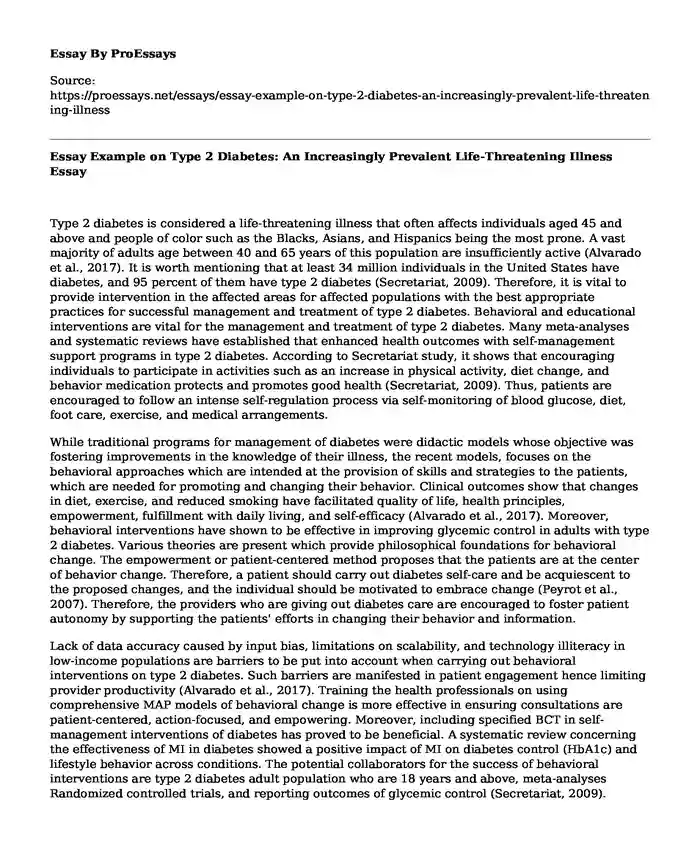Type 2 diabetes is considered a life-threatening illness that often affects individuals aged 45 and above and people of color such as the Blacks, Asians, and Hispanics being the most prone. A vast majority of adults age between 40 and 65 years of this population are insufficiently active (Alvarado et al., 2017). It is worth mentioning that at least 34 million individuals in the United States have diabetes, and 95 percent of them have type 2 diabetes (Secretariat, 2009). Therefore, it is vital to provide intervention in the affected areas for affected populations with the best appropriate practices for successful management and treatment of type 2 diabetes. Behavioral and educational interventions are vital for the management and treatment of type 2 diabetes. Many meta-analyses and systematic reviews have established that enhanced health outcomes with self-management support programs in type 2 diabetes. According to Secretariat study, it shows that encouraging individuals to participate in activities such as an increase in physical activity, diet change, and behavior medication protects and promotes good health (Secretariat, 2009). Thus, patients are encouraged to follow an intense self-regulation process via self-monitoring of blood glucose, diet, foot care, exercise, and medical arrangements.
While traditional programs for management of diabetes were didactic models whose objective was fostering improvements in the knowledge of their illness, the recent models, focuses on the behavioral approaches which are intended at the provision of skills and strategies to the patients, which are needed for promoting and changing their behavior. Clinical outcomes show that changes in diet, exercise, and reduced smoking have facilitated quality of life, health principles, empowerment, fulfillment with daily living, and self-efficacy (Alvarado et al., 2017). Moreover, behavioral interventions have shown to be effective in improving glycemic control in adults with type 2 diabetes. Various theories are present which provide philosophical foundations for behavioral change. The empowerment or patient-centered method proposes that the patients are at the center of behavior change. Therefore, a patient should carry out diabetes self-care and be acquiescent to the proposed changes, and the individual should be motivated to embrace change (Peyrot et al., 2007). Therefore, the providers who are giving out diabetes care are encouraged to foster patient autonomy by supporting the patients' efforts in changing their behavior and information.
Lack of data accuracy caused by input bias, limitations on scalability, and technology illiteracy in low-income populations are barriers to be put into account when carrying out behavioral interventions on type 2 diabetes. Such barriers are manifested in patient engagement hence limiting provider productivity (Alvarado et al., 2017). Training the health professionals on using comprehensive MAP models of behavioral change is more effective in ensuring consultations are patient-centered, action-focused, and empowering. Moreover, including specified BCT in self-management interventions of diabetes has proved to be beneficial. A systematic review concerning the effectiveness of MI in diabetes showed a positive impact of MI on diabetes control (HbA1c) and lifestyle behavior across conditions. The potential collaborators for the success of behavioral interventions are type 2 diabetes adult population who are 18 years and above, meta-analyses Randomized controlled trials, and reporting outcomes of glycemic control (Secretariat, 2009).
Conclusion
In summation, Intervening actions or preventive measures consist of consuming healthy diets, being physically active at least 30 minutes per day, losing weight, and avoiding sitting for long periods. A large number of the given preventive measures focus on the controlling body weight to avoid being overweight and living a healthy life.
References
Alvarado, M. M., Kum, H. C., Coronado, K. G., Foster, M. J., Ortega, P., & Lawley, M. A. (2017). Barriers to remote health interventions for type 2 diabetes: a systematic review and proposed classification scheme. Journal of medical Internet research, 19(2), e28.
Peyrot, M., & Rubin, R. R. (2007). Behavioral and psychosocial interventions in diabetes: a conceptual review. Diabetes care, 30(10), 2433-2440.
Secretariat, M. A. (2009). Behavioral interventions for type 2 diabetes: an evidence-based analysis. Ontario health technology assessment series, 9(21), 1.
Cite this page
Essay Example on Type 2 Diabetes: An Increasingly Prevalent Life-Threatening Illness. (2023, Sep 17). Retrieved from https://proessays.net/essays/essay-example-on-type-2-diabetes-an-increasingly-prevalent-life-threatening-illness
If you are the original author of this essay and no longer wish to have it published on the ProEssays website, please click below to request its removal:
- Essay Sample: Analysis of the Hospital's Project of Free Children's Cancer Screening
- Cancer Among Asian Americans Essay
- Essay Sample on Angiotensin-Converting-Enzyme Inhibitor
- Short-term Placement of New Nurses: Impact on Poor Patient Outcomes - Essay Sample
- Nutritional Ergogenic Aids: Enhancing Performance & Recovery - Essay Sample
- Still Alice (2014) - Movie Review Sample
- Essay Example on Transitional Care Models







